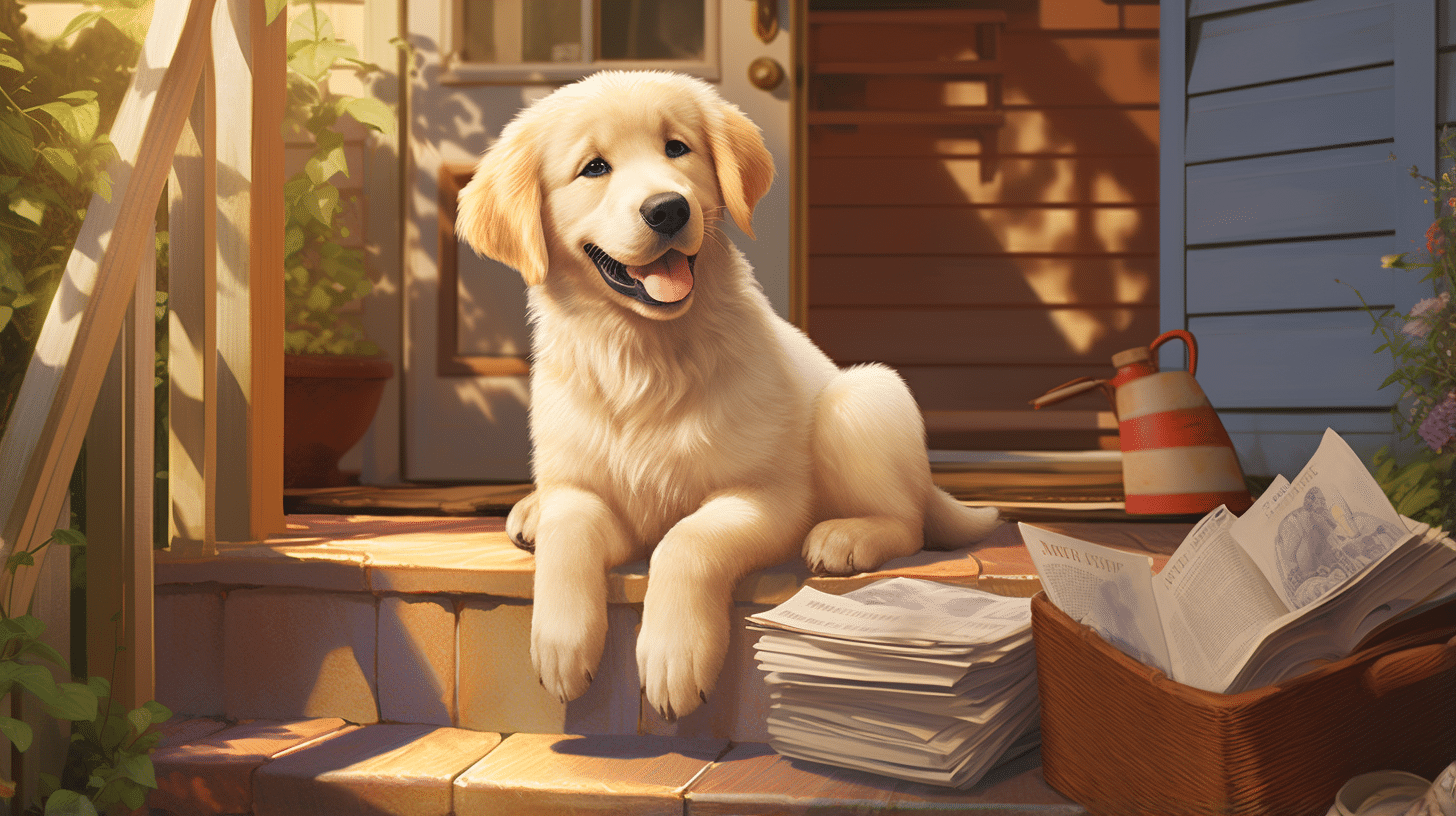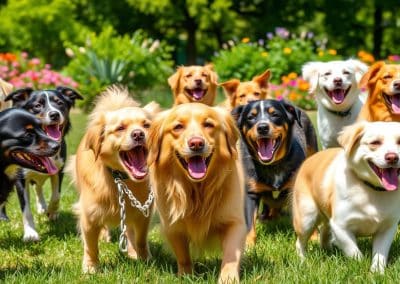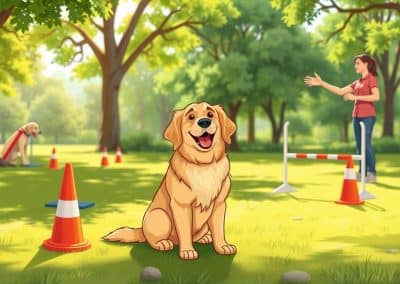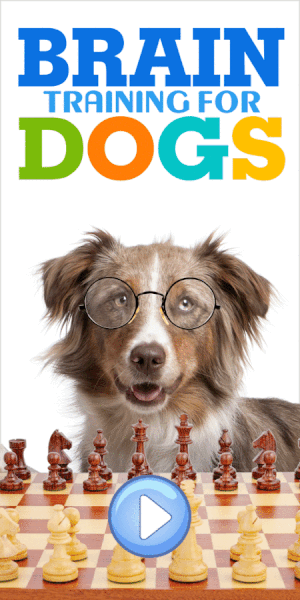How to House Train Your Golden Retriever. House training your golden retriever can be a challenging task, but it is an essential part of being a responsible pet owner. Golden retrievers are intelligent and eager to please, making them relatively easy to train. However, they have a stubborn streak that can make house training more complicated than other breeds.
Understanding Golden Retriever Behaviors is the first step in house training your pup. Golden retrievers are social animals and crave attention from their owners. They are also prone to separation anxiety, which can lead to destructive behaviors such as chewing and digging. Knowing these behaviors will help you create a training plan that addresses your pup’s needs.
Preparation for Training is crucial in ensuring a successful house training experience. Before bringing your golden retriever home, you should have a designated area for them to sleep, eat, and play. You should also have the necessary supplies such as a crate, leash, and treats. Being prepared will make the transition to their new home smoother and help establish a routine that will aid in house training.
Key Takeaways
- Understanding Golden Retriever behaviors is crucial in creating a successful training plan.
- Preparation for training, such as having a designated area and necessary supplies, is essential in establishing a routine.
- Consistency in training and positive reinforcement techniques are key to successful house training.
Understanding Golden Retriever Behaviors
Golden Retrievers are known for their friendly, outgoing personalities and make excellent family pets. They are intelligent, energetic, and eager to please, which makes them great working dogs as well. However, understanding their behaviors is crucial to successfully house train your Golden Retriever.
One of the most important things to know about Golden Retrievers is that they are intelligent dogs. They have been bred for generations to be working dogs, which means they are highly trainable and eager to please their owners. This intelligence can be used to your advantage when house training, as they can quickly learn what is expected of them.
Golden Retrievers are also high-energy dogs, which means they need plenty of exercise and playtime. This energy can sometimes lead to destructive behavior if they are not given enough attention or exercise. It’s important to provide them with plenty of opportunities to burn off their energy, whether it’s through walks, runs, or playtime in the backyard.
Another important behavior to understand is their eagerness to please. Golden Retrievers want nothing more than to make their owners happy, which makes them great candidates for training. However, this eagerness can also lead to separation anxiety if they are left alone for too long. It’s important to gradually acclimate them to being alone and provide them with plenty of toys and distractions to keep them occupied.
Overall, understanding Golden Retriever behaviors is crucial to successfully house train your furry friend. With their intelligence, energy, and eagerness to please, they make great pets and working dogs. By providing them with plenty of exercise, attention, and training, you can ensure a happy and well-behaved Golden Retriever.
Preparation for Training
Before starting to train a Golden Retriever puppy, it is important to make sure that the right equipment is available. This includes a collar or harness, a leash, and baby gates.
A collar or harness is essential for controlling the puppy during walks and training sessions. Choose a collar or harness that fits properly and is comfortable for the puppy. A collar that is too tight can cause discomfort and even injury, while a collar that is too loose can slip off and put the puppy in danger.
A leash is also necessary for controlling the puppy during walks and training sessions. It is essential to choose a leash that is the right length and strength for the puppy. A leash that is too short can cause discomfort and restrict the puppy’s movement, while a leash that is too long can make it difficult to control the puppy.
Baby gates are useful for keeping the puppy in a designated area during training sessions and when the owner is not able to supervise the puppy. You should choose baby gates that are sturdy and tall enough to keep the puppy from jumping over or crawling under.
In addition to equipment, it is important to provide the puppy with soft bedding to sleep on. This can include blankets, towels, or a dog bed. Soft bedding provides comfort and warmth for the puppy, which can help reduce stress and promote relaxation.
Overall, preparation is key when it comes to training a Golden Retriever puppy. By having the right equipment and environment, the puppy will be more comfortable and receptive to training.
Basic Obedience Training
Basic obedience training is an essential part of house training your Golden Retriever. It helps your dog develop good behavior and manners, which is important for their safety and happiness. Basic obedience training involves teaching your dog a set of rules and obedience skills that they need to follow.
Some of the basic obedience skills include sitting, staying, coming, and walking on a leash. These skills are important for your dog to learn as they help them develop good behavior and manners. They also help you control your dog and keep them safe in different situations.
To start with basic obedience training, you need to establish a set of basic commands that your dog needs to follow. These commands should be simple and easy to understand. Some of the basic commands include sit, stay, come, and heel.
When teaching your dog these commands, it is important to use positive reinforcement. This means rewarding your dog when they follow the command correctly. You can use treats or verbal praise to reward your dog.
It is also important to be consistent when teaching your dog basic obedience skills. You should use the same commands every time and reward your dog consistently when they follow the command correctly.
Overall, basic obedience training is an important part of house training your Golden Retriever. It helps your dog develop good behavior and manners, which is important for their safety and happiness. By using positive reinforcement and being consistent, you can teach your dog basic obedience skills and set them up for success.
House Training Your Golden Retriever
House training a Golden Retriever can be a challenging task, but it is an essential part of owning a puppy. The first step to successful house training is to establish a routine. This routine should include regular feeding times, exercise, playtime, and potty breaks. By following a consistent schedule, your Golden Retriever puppy will learn when it is time to go out and eliminate.
It is important to keep in mind that puppies have small bladders and need to go out frequently. Vigilance and constant supervision are necessary during the house training process. Keep an eye on your puppy’s behavior and take them outside immediately if they show signs of needing to go, such as sniffing around or circling.
One effective method of house training is crate training. This involves using a crate to confine your puppy when you cannot supervise them. Dogs have a natural instinct not to soil their sleeping area, so they will learn to hold it until you take them outside. Make sure the crate is the right size for your puppy, with enough room to stand up, turn around, and lie down comfortably.
Another option is to use puppy pads. These are absorbent pads that can be placed in a designated area of your home for your puppy to use as a bathroom. This can be helpful if you live in an apartment or have limited outdoor space. However, it is important to note that using puppy pads can prolong the house training process and confuse your puppy about where they are supposed to go.
Consistency is key when house training your Golden Retriever. Use positive reinforcement, such as treats and praise, when your puppy eliminates outside. Avoid punishment or scolding if your puppy has an accident inside, as this can cause fear and anxiety. With patience and persistence, your Golden Retriever puppy will learn to become a well-trained and obedient companion.
Leash Training
Leash training is an essential part of house training your Golden Retriever. It helps your dog learn how to walk calmly on a leash without pulling or tugging. This is crucial for both the dog’s safety and the owner’s comfort.
When leash training your Golden Retriever, it is important to use a leash that is the appropriate length and strength. A good leash should be long enough to allow your dog to explore and move around but short enough to keep them close to you. It should also be strong enough to handle any sudden movements or pulling.
To start leash training, begin by attaching the leash to your dog’s collar or harness. Allow your dog to get used to the weight of the leash by letting them drag it around for a few minutes each day. Once your dog is comfortable with the leash, start walking with them.
If your dog pulls on the leash, stop walking and wait for them to come back to you. Reward your dog with a treat or praise when they are walking calmly beside you. Repeat this process until your dog learns to walk calmly on the leash without pulling.
It is important to be patient and consistent when leash training your Golden Retriever. Don’t get frustrated if your dog doesn’t learn right away. With time and practice, your dog will learn to walk calmly on the leash.
Crate Training
Crate training is an effective method to house train your Golden Retriever. It can help accelerate potty training, as dogs do not like to go where they sleep, so they will typically hold it while in the crate. Additionally, crate training can help keep your dog safe when you are not around to supervise them.
When selecting a crate for your Golden Retriever, make sure it’s the right size. The crate should be large enough for your dog to stand up, turn around, and lay down comfortably. If the crate is too big, your dog may use one end as a bathroom and the other for sleeping, which defeats the purpose of crate training.
Acclimate your Golden Retriever to the crate gradually. Start by placing treats and toys inside the crate and leaving the door open. Once your dog is comfortable going in and out of the crate, begin closing the door for short periods while you are home. Gradually increase the amount of time your dog spends in the crate until they are comfortable being in there for several hours.
It’s important to note that you should never use the crate as punishment. The crate should be a safe and comfortable space for your dog, not a place of fear or anxiety. With patience and consistency, your Golden Retriever can learn to love their crate and see it as a cozy den.
Socialization Skills
Socializing a Golden Retriever is an essential part of their training. It helps them develop the necessary skills to interact with other dogs and people. A well-socialized Golden Retriever is more confident, happy, and friendly.
To socialize a Golden Retriever, it is important to introduce them to different situations and environments. This can include meeting new people, visiting new places, and interacting with other dogs. It is important to do this in a controlled and safe manner to prevent any negative experiences.
One way to socialize a Golden Retriever is to take them to a dog park or attend a dog training class. This allows them to interact with other dogs and learn how to behave in a group setting. It is important to supervise their interactions and intervene if necessary to prevent any aggressive behavior.
Another way to socialize a Golden Retriever is to expose them to different types of people. This can include children, adults, and seniors. It is important to teach them how to behave around different age groups and to be gentle and friendly.
It is also important to introduce a Golden Retriever to different companions. This can include other pets such as cats or birds. It is important to supervise their interactions and prevent any aggressive behavior.
Overall, socialization is an important part of a Golden Retriever’s training. It helps them develop the necessary skills to interact with other dogs and people in a friendly and confident manner.
Training Sessions and Techniques
Training a Golden Retriever requires patience, consistency, and positive reinforcement. House training is no different. It requires a structured approach that involves regular training sessions and the use of treats, rewards, and praise.
Training Sessions
Training sessions should be short and frequent. A good rule of thumb is to schedule three to four sessions per day, each lasting no longer than 10 to 15 minutes. This approach will help keep your puppy engaged and focused on the task at hand. It will also help prevent fatigue and frustration.
Techniques
There are several techniques that can be used to house train your Golden Retriever. One popular method is clicker training. This technique involves using a clicker to mark the desired behavior and then rewarding the puppy with a treat. The clicker serves as a signal that the puppy has done something right, and the treat reinforces the behavior.
Another effective technique is to use training treats. These are small, bite-sized treats that are specifically designed for training. They are usually high in protein and low in calories, making them a healthy and effective way to reward your puppy.
Rewards and Praise
Rewards and praise are essential components of house training. Whenever your puppy exhibits the desired behavior, be sure to reward them with a treat and plenty of praise. This positive reinforcement will help your puppy associate the behavior with a positive outcome, making them more likely to repeat it in the future.
Conclusion
In conclusion, house training a Golden Retriever requires patience, consistency, and positive reinforcement. By scheduling regular training sessions, using effective techniques, and rewarding your puppy with treats and praise, you can help them develop good habits and become a well-behaved member of your family.
Consistency in Training
Consistency is key when it comes to house training your Golden Retriever. It is important to have the same rules and expectations for your dog throughout the training process. This means that everyone in the household should be on board with the same training methods and rules.
For example, if you do not want your Golden Retriever to jump on people, then you should never allow him to do it, even if it is just one time. If your dog is allowed to jump on you one day and not the next, then he will be confused and may continue the behavior.
Consistency also means having a set routine for your dog. Dogs thrive on routine and having a consistent schedule for feeding, potty breaks, and playtime will help them learn what is expected of them.
In addition to having a consistent routine, it is important to use the same commands and cues when training your Golden Retriever. For example, if you use the command “sit” to get your dog to sit, then everyone in the household should use the same command. Using different commands or cues can confuse your dog and make training more difficult.
It is important to note that consistency does not mean being harsh or punishing your dog. Positive reinforcement is the most effective way to train your Golden Retriever. Consistently rewarding good behavior with treats, praise, or playtime will encourage your dog to continue the behavior.
In summary, consistency is crucial when it comes to house training your Golden Retriever. Having the same rules and expectations, a set routine, using the same commands and cues, and positive reinforcement will all contribute to a successful training experience.
Advanced Skills and Tricks
Once your golden retriever has mastered the basics of house training, it’s time to move on to more advanced skills and tricks. These can help to keep your dog mentally stimulated and engaged, while also providing an opportunity for bonding and fun.
Trick Training
Golden retrievers are known for their intelligence and eagerness to please, making them great candidates for trick training. Here are a few fun tricks to try with your furry friend:
- Roll Over: Start by having your dog lay down. Then, hold a treat close to their nose and slowly move it towards their shoulder. This should cause them to roll onto their back. When they do, give them the treat and praise them. Repeat until they can do it on command.
- Speak: Get your dog excited by using a high-pitched voice or making a noise they like. When they start barking, say “speak” and reward them with a treat. Repeat until they can bark on command.
- Play Dead: Have your dog lay down on their side. Then, gently roll them onto their back and hold them there for a few seconds. When they stay still, reward them with a treat and praise them. Repeat until they can do it on command.
Skill Building
In addition to tricks, it’s important to continue building your golden retriever’s skills. Here are a few areas to focus on:
- Obedience: Continue working on basic obedience commands like sit, stay, come, and heel. These will help keep your dog safe and well-behaved in various situations.
- Agility: Set up an agility course in your backyard or take your dog to a local class. This can help improve their coordination, balance, and confidence.
- Scent Work: Golden retrievers have a great sense of smell, so try incorporating scent work into your training. Hide treats or toys around the house and encourage your dog to find them using their nose.
By continuing to train and challenge your golden retriever, you can help them reach their full potential and strengthen the bond between you.
Dealing with Common Puppy Issues
House training a Golden Retriever puppy can be a challenging task. Puppies are known for their curious and playful nature, which can lead to some common issues during the house training process. Here are a few tips and tricks to help deal with some of the most common puppy issues:
Age and Teething
Puppies go through a teething phase between the ages of 3 and 6 months. During this time, they may chew on anything they can get their paws on, including furniture, shoes, and even walls. To prevent destructive chewing, make sure your puppy has access to plenty of chew toys. Frozen toys can be especially helpful for teething puppies, as they can help soothe sore gums.
Accidents in the House
Accidents are bound to happen during the house training process, but it’s important to remain patient and consistent. When accidents do occur, use an enzymatic cleaner to thoroughly clean the area. This will help remove any lingering odor that may attract your puppy back to the same spot.
Lack of Progress
If you find that your puppy is not making progress with house training, it may be time to reassess your approach. Make sure you are following a consistent routine and providing plenty of opportunities for your puppy to go outside. Consider crate training your puppy to help prevent accidents when you are not able to supervise them.
Destructive Behavior
Destructive behavior can be a sign that your puppy is not getting enough exercise or mental stimulation. Make sure your puppy is getting enough exercise each day and providing plenty of toys and puzzles to keep their minds engaged.
By addressing these common puppy issues, you can help make the house training process a smoother and more successful experience for both you and your furry friend.
Maintaining Safety During Training
Training a Golden Retriever puppy can be a fun and rewarding experience, but it is important to prioritize safety during the process. Here are some tips to help maintain safety during training:
Supervision
One of the most important aspects of maintaining safety during training is to always supervise your puppy. Never leave your puppy alone during training, as this can lead to accidents and injuries. Keep a close eye on your puppy at all times, and be ready to intervene if they start to exhibit dangerous behavior.
Use Positive Reinforcement
Positive reinforcement is a key aspect of effective training, but it is also important for safety. Avoid using punishment or physical corrections during training, as this can lead to fear and aggression in your puppy. Instead, use positive reinforcement techniques such as treats, praise, and playtime to encourage good behavior.
Use Appropriate Equipment
Using the right equipment is also important for maintaining safety during training. Make sure that collars, leashes, and other training tools are properly fitted and appropriate for your puppy’s size and age. Avoid using choke chains or prong collars, as these can cause injury and discomfort.
Keep Training Sessions Short
Training sessions should be kept short and sweet, especially for young puppies. Long training sessions can lead to frustration and boredom, which can lead to dangerous behavior. Keep training sessions to no more than 10-15 minutes at a time, and take frequent breaks to allow your puppy to rest and recharge.
Stay Patient and Consistent
Finally, it is important to stay patient and consistent during training. Golden Retrievers are intelligent and eager to please, but they can also be stubborn and independent at times. Stay calm and patient during training, and be consistent with your commands and expectations. With time and practice, your puppy will learn to behave safely and appropriately.
Grooming and Care
Grooming is an essential part of taking care of your Golden Retriever. Regular grooming not only keeps your dog looking great, but it also helps maintain their overall health and well-being. Here are some tips on how to groom your Golden Retriever properly:
Brushing
Golden Retrievers have a double coat that sheds heavily twice a year. To keep their coat looking healthy and shiny, it’s important to brush them regularly. Brushing also helps remove any loose hair and dirt that may be trapped in their coat.
Use a slicker brush to brush your Golden Retriever’s coat from head to tail. Start at the head and work your way down to the tail, making sure to brush in the direction of the hair growth. Be gentle when brushing around sensitive areas like the ears and belly.
Bathing
Bathing your Golden Retriever is an important part of their grooming routine. However, it’s important not to over-bathe them as it can strip their coat of its natural oils.
Use a mild dog shampoo and warm water to bathe your Golden Retriever. Wet their coat thoroughly and lather up the shampoo. Rinse thoroughly to remove all the soap and towel dry your dog.
Nail Trimming
Golden Retrievers have strong, fast-growing nails that need to be trimmed regularly. Long nails can cause discomfort and even lead to joint problems.
Use a pair of dog nail clippers to trim your Golden Retriever’s nails. Be cautious not to cut the quick, which is the pink part of the nail that contains blood vessels. If you’re unsure about how to trim your dog’s nails, consult with a professional groomer or veterinarian.
Dental Care
Good dental hygiene is important for your Golden Retriever’s overall health. Brush their teeth regularly with a soft-bristled toothbrush and dog-friendly toothpaste. You can also offer dental chews or toys to help keep their teeth clean.
Bonding
Grooming is not just about keeping your Golden Retriever looking good, it’s also an opportunity to bond with your dog. Take your time when grooming your dog and use it as an opportunity to show them love and affection. This will help build a strong bond between you and your dog.
By following these grooming tips, you can help keep your Golden Retriever looking and feeling their best. Remember to be patient and gentle when grooming your dog, and use it as an opportunity to bond with them.
When to Seek Professional Help
House training a furry friend can be a challenging task, and sometimes even with consistent effort, it may not be successful. If an adult Golden Retriever is still not house trained after several weeks of consistent training, it may be time to seek professional help from a dog trainer.
A dog trainer can provide personalized guidance and training techniques that are tailored to the specific needs of the Golden Retriever. They can also identify any underlying behavioral issues that may be contributing to the house training difficulties.
It is important to note that seeking professional help does not mean that the owner has failed in their efforts to house train their Golden Retriever. Rather, it is an acknowledgment that the owner is committed to providing the best possible care for their furry friend and is willing to seek additional support when needed.
Some signs that it may be time to seek professional help include:
- The Golden Retriever continues to have accidents inside the house despite consistent training efforts.
- The Golden Retriever shows signs of anxiety or stress related to house training.
- The owner is struggling to maintain consistency in the training process due to a busy schedule or other factors.
When seeking professional help, choose a reputable and experienced dog trainer who uses positive reinforcement techniques. The trainer should also be able to provide references and have a track record of success in house training Golden Retrievers.
Overall, seeking professional help can be a valuable resource for owners who are struggling with house training their Golden Retriever. With the right guidance and support, even the most stubborn furry friend can learn to become a well-behaved and house-trained companion.
Conclusion
In conclusion, house training a Golden Retriever puppy can be a challenging task, but with the right approach and patience, it can be a smooth and successful process. By following the golden rules of establishing a routine, providing positive reinforcement, and setting clear boundaries, you can help your puppy learn where and when to eliminate.
It is important to keep the training sessions fun and positive, as Golden Retrievers have a short attention span and respond well to gentle encouragement. Using food treats as a reward can also be an effective way to reinforce good behavior.
Establishing a daily routine is essential to house training success. This routine should include regular potty breaks, feeding times, and playtime. By sticking to a consistent schedule, your puppy will learn what is expected of them and when.
Setting clear boundaries is also important. This includes designating a specific elimination area, using a crate or playpen for confinement, and supervising your puppy when they are out of their designated area.
Overall, house training a Golden Retriever puppy requires patience, consistency, and a positive attitude. With these tips and tricks, you can help your puppy learn the proper elimination habits and set them up for success as a well-behaved and happy family member.
Frequently Asked Questions
How long does it take to house train a Golden Retriever?
House training a Golden Retriever can take anywhere from a few weeks to a few months. It largely depends on the individual puppy and their temperament, as well as the consistency and dedication of the owner. It’s important to be patient and consistent with training, and not to get discouraged by setbacks or accidents.
What are some effective methods for potty training a Golden Retriever?
Some effective methods for potty training a Golden Retriever include establishing a consistent routine, using positive reinforcement, and closely supervising the puppy when they are indoors. It’s also important to take the puppy outside frequently, especially after meals or naps, and to reward them immediately when they go potty outside.
How can I prevent my Golden Retriever from having accidents in the house?
Preventing accidents in the house largely comes down to supervision and consistency. It’s important to keep a close eye on the puppy when they are indoors, and to establish a consistent routine for taking them outside. It’s also important to clean up accidents thoroughly with an enzymatic cleaner to remove any lingering scent that might attract the puppy to go potty in the same spot again.
What are some tips for crate training a Golden Retriever puppy?
Some tips for crate training a Golden Retriever puppy include making the crate a positive and comfortable space, gradually increasing the amount of time the puppy spends in the crate, and never using the crate as a form of punishment. It’s also important to introduce the crate slowly and positively, and to make sure the puppy has plenty of exercise and mental stimulation outside of the crate.
How do I teach my Golden Retriever to signal when they need to go outside?
Teaching a Golden Retriever to signal when they need to go outside can be done through consistent training and positive reinforcement. One method is to hang a bell near the door and teach the puppy to ring it with their nose when they need to go outside. It’s important to be consistent with the training and to reward the puppy immediately when they signal to go outside.
What should I do if my Golden Retriever is having difficulty with house training?
If a Golden Retriever is having difficulty with house training, it’s important to assess the situation and make any necessary adjustments to the training routine. This might include increasing the frequency of potty breaks, changing the type of reward used for positive reinforcement, or seeking the advice of a professional dog trainer. It’s important to be patient and consistent with training, and not to get discouraged by setbacks or accidents.









